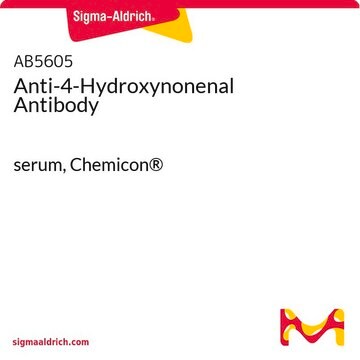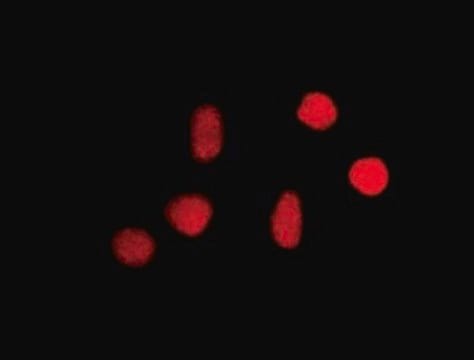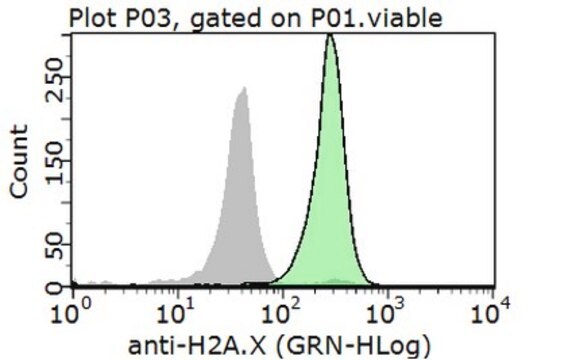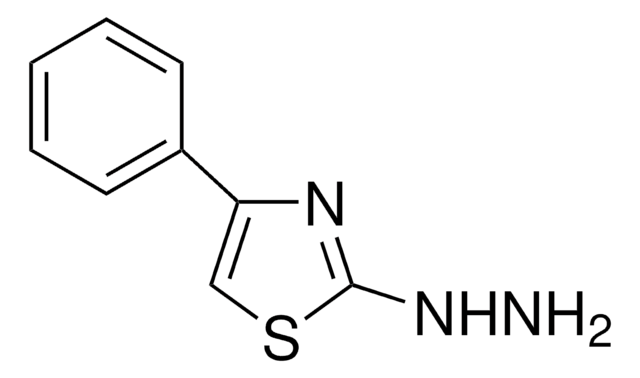AB5830
Anti-8-Hydroxydeoxyguanosine Antibody
serum, Chemicon®
Synonym(s):
8-OHdG, 8-hydroxy-2′-deoxyguanosine
Sign Into View Organizational & Contract Pricing
All Photos(1)
About This Item
UNSPSC Code:
12352203
eCl@ss:
32160702
NACRES:
NA.41
Recommended Products
biological source
goat
Quality Level
antibody form
serum
antibody product type
primary antibodies
clone
polyclonal
species reactivity
human
manufacturer/tradename
Chemicon®
technique(s)
ELISA: suitable
immunohistochemistry: suitable (paraffin)
shipped in
dry ice
target post-translational modification
unmodified
General description
8-Hydroxydeoxyguanosine (8OHdG) is a modified base that occurs in DNA due to attack by hydroxyl radicals that are formed as byproducts and intermediates of aerobic metabolism and during oxidative stress. There is increasing evidence to support the involvement of free radical reactions in the damage of biomolecules that eventually lead to several diseases in humans, such as atherosclerosis, cerebral and heart ischemia-reperfusion injury, cancer, rheumatoid arthritis, inflammation, diabetes, aging, and neurodegenerative conditions, such as Alzheimer′s disease.
8OHdG has become increasing popular as a sensitive, stable and integral marker of oxidative damage in cellular DNA. Biomonitoring in humans has demonstrated that 8OHdG can be excreted in the urine, and that a significant increase is caused by exposure to tobacco smoke and ionizing radiation. Because 8OHdG is so well correlated with oxidative stress and damage to DNA, which leads to degenerative disease states, the development of an antibody that can be used to study DNA damage has numerous applications. In addition to the direct study of DNA damage within cells, this antibody has applications in the development of immunoassays that can monitor 8OHdG excretion in the urine and serve as a biomarker of oxidative stress. Industrial uses may extend to the dietary supplement manufacturers, who could benefit from an immunoassay that could be used to test the effectiveness of antioxidants and other nutraceuticals.
CHEMICON′s new goat antiserum to 8-hydroxyguanosine is now available. This antiserum has been shown by ELISA to be completely cross-reactive with 8-hydroxydeoxyguanosine while not cross-reacting with other naturally occurring nucleotides. This antibody should be a valuable tool for scientists working to understand the role of free radical damage in a number of human disease states.
8OHdG has become increasing popular as a sensitive, stable and integral marker of oxidative damage in cellular DNA. Biomonitoring in humans has demonstrated that 8OHdG can be excreted in the urine, and that a significant increase is caused by exposure to tobacco smoke and ionizing radiation. Because 8OHdG is so well correlated with oxidative stress and damage to DNA, which leads to degenerative disease states, the development of an antibody that can be used to study DNA damage has numerous applications. In addition to the direct study of DNA damage within cells, this antibody has applications in the development of immunoassays that can monitor 8OHdG excretion in the urine and serve as a biomarker of oxidative stress. Industrial uses may extend to the dietary supplement manufacturers, who could benefit from an immunoassay that could be used to test the effectiveness of antioxidants and other nutraceuticals.
CHEMICON′s new goat antiserum to 8-hydroxyguanosine is now available. This antiserum has been shown by ELISA to be completely cross-reactive with 8-hydroxydeoxyguanosine while not cross-reacting with other naturally occurring nucleotides. This antibody should be a valuable tool for scientists working to understand the role of free radical damage in a number of human disease states.
Specificity
Reacts with 8-Hydroxydeoxyguanosine (8-OHdG) and 8-Hydroxyguanosine (8-OHG). By a competitive ELISA the antibody was 100% inhibited by 8-hydroxydeoxyguanosine and 8-hydroxyguanosine nucleotides. Partial cross-reactivity was observed with 8-mercaptoguanosine (80%) while 8-bromoguanosine showed some cross-reactivity (5%). 2-Deoxyadenosine, 7-methlyguanosine, guanosine monophosphate and guanosine showed no reactivity.
Immunogen
8-Hydroxy-2′-deoxyguanosine and 8-hydroxyguanosine.
Application
Immunohistochemistry: >1:200 on paraffin embedded, formalin fixed human brain. It is suggested that the tissues are pretreated with 10 μg/mL of proteinase K for 40 minutes at 37°C prior to staining.
Dewaxed sections treated with 3%H2O2 in methanol for 30 minutes and blocking was with 10% NGS in TBS. Sections were treated with proteinase K 10ug/ml in PBS pH 7.4, 40 minutes 37C prior to blocking. Detection is via DAB. Since the antibody is staining a nucleic acid it is important to use enough proteinase to penetrate the histone barrier.
Optimal working dilutions must be determined by the end user.
Dewaxed sections treated with 3%H2O2 in methanol for 30 minutes and blocking was with 10% NGS in TBS. Sections were treated with proteinase K 10ug/ml in PBS pH 7.4, 40 minutes 37C prior to blocking. Detection is via DAB. Since the antibody is staining a nucleic acid it is important to use enough proteinase to penetrate the histone barrier.
Optimal working dilutions must be determined by the end user.
This Anti-8-Hydroxydeoxyguanosine Antibody is validated for use in ELISA, IH(P) for the detection of 8-Hydroxydeoxyguanosine.
Analysis Note
Control
Skin, staining is limited to the nucleus.
Skin, staining is limited to the nucleus.
Other Notes
Concentration: Please refer to the Certificate of Analysis for the lot-specific concentration.
Legal Information
CHEMICON is a registered trademark of Merck KGaA, Darmstadt, Germany
Not finding the right product?
Try our Product Selector Tool.
Storage Class Code
12 - Non Combustible Liquids
WGK
WGK 1
Flash Point(F)
Not applicable
Flash Point(C)
Not applicable
Certificates of Analysis (COA)
Search for Certificates of Analysis (COA) by entering the products Lot/Batch Number. Lot and Batch Numbers can be found on a product’s label following the words ‘Lot’ or ‘Batch’.
Already Own This Product?
Find documentation for the products that you have recently purchased in the Document Library.
Wei Ma et al.
Molecular medicine reports, 12(4), 5026-5034 (2015-07-15)
The present study aimed to investigate the ability of SS31, a novel mitochondria‑targeted peptide to protect against t‑BHP‑induced mitochondrial dysfunction and apoptosis in 661W cell lines. The 661W cells were treated with various concentrations of SS‑31 and an MTT assay
Cailing Liu et al.
Proceedings of the National Academy of Sciences of the United States of America, 117(1), 573-583 (2019-12-20)
Fuchs endothelial corneal dystrophy (FECD) is a leading cause of corneal endothelial (CE) degeneration resulting in impaired visual acuity. It is a genetically complex and age-related disorder, with higher incidence in females. In this study, we established a nongenetic FECD
Johnson Chia-Shen Yang et al.
Journal of clinical medicine, 10(7) (2021-05-01)
Excess lymphedematous tissue causes excessive oxidative stress in lymphedema. Lymphaticovenous anastomosis (LVA) supermicrosurgery is currently emerging as the first-line surgical intervention for lymphedema. No data are available regarding the changes in serum proteins correlating to oxidative stress and antioxidant capacity
E Deruy et al.
Cell death & disease, 5, e1577-e1577 (2014-12-19)
Senescence is a non-proliferative state reached by normal cells in response to various stresses, including telomere uncapping, oxidative stress or oncogene activation. In previous reports, we have highlighted that senescent human epidermal keratinocytes have two opposite outcomes: either they die
Xiaowen Zhao et al.
BMC ophthalmology, 16, 16-16 (2016-02-04)
The purpose of this study was to address the question of how the premature senescence process may affect corneal endothelium after penetrating keratoplasty, because the quality of donor corneal endothelial cells is important for corneal transplant success. The cell senescence
Our team of scientists has experience in all areas of research including Life Science, Material Science, Chemical Synthesis, Chromatography, Analytical and many others.
Contact Technical Service








